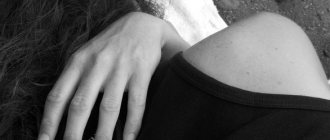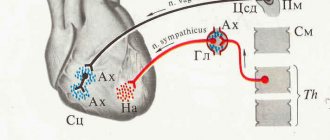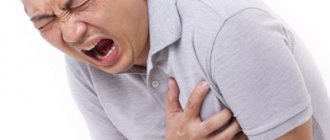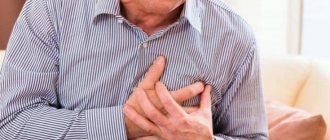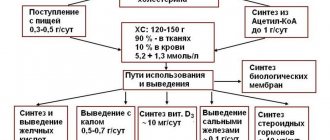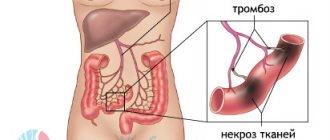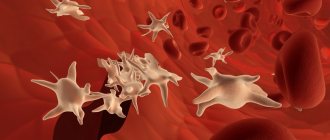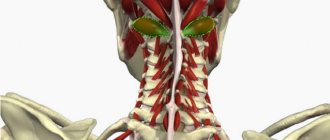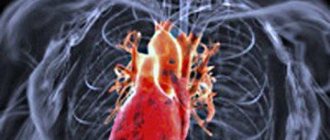Before discussing this topic in more detail, it is necessary to clarify that heart pain is by no means a joke. If you suspect this condition, you should consult a doctor, since without a detailed history and routine studies (ECG, cardiac auscultation, etc.), an accurate diagnosis is impossible. How to recognize heartache from another? This will be discussed in the article.
Angina pectoris
How does heart pain manifest itself in the form of an angina attack:
- The pain with this pathology is squeezing, pressing, and sometimes burning. It is worth noting: breathing or changing the patient’s body position will have virtually no effect on the intensity of the pain.
- Angina pectoris will manifest itself when a person is physically and emotionally stressed. Although it can also happen at rest, even during sleep, it is less common.
- When inhaling, colitis in the region of the heart.
- Duration ranges from 2 to 15 minutes.
- Localized in the retrosternal region, sometimes it “radiates” to the arms (usually to the left), but not always; irradiation may well be to the back, neck, and also the lower jaw.
Where does your heart hurt?
Typical localization of pain
Typical chest pain refers to the clinical manifestation of ordinary angina. The heart hurts behind the sternum and radiates to the upper limb, collarbone, neck, lower jaw on the left. To identify the painful area, patients point to the mid-left area of the chest. These symptoms are very similar to myocardial infarction.
Atypical localization of pain
There are situations when a man focuses on areas of irradiation and describes them first, which is already regarded as atypical angina. Sometimes the individual characteristics of the innervation of internal organs determine the fact that it hurts at the level of the stomach, in the subcostal area.
The nature of this symptom in this case is more diffuse, bursting, pressing. And sometimes vegetative symptoms come to the fore, when the heart hurts, but not so much. With dextracardia, the pain is more on the right side.
Pericarditis
Pericarditis has the following symptoms of heart pain:
- With pericarditis, the pain is sharp and dull of varying intensity.
- It does not increase immediately, but gradually, at the peak of the process it can decrease and even disappear, but then it intensifies again. Often changes are associated with the patient’s body position and breathing.
- Duration is several days.
- Localization will be in the retrosternal region, sometimes radiating to the neck, back, and also to the shoulders and epigastric region.
Aortic dissection
Aortic dissection manifests itself with the following symptoms of heart pain:
- The pain is very intense and often comes in waves.
- The onset is immediate, often against the background of arterial hypertension, sometimes during physical and emotional stress. There may also be the presence of neurological symptoms.
- Duration with a very wide range, can be from several minutes to several days.
- Localization in the retrosternal region with “recoil” along the spinal column and along the branches of the aorta (to the stomach, back, neck and ears).
TELA
How to determine heart pain during pulmonary embolism (PE):
- The pain is acute and intense, there is a high probability of developing shock, which occurs against the background of very pronounced shortness of breath.
- It appears suddenly, and against the background of a long period of bed rest, after surgery on the organs of the abdomen, pelvis, and lower extremities. In people suffering from thrombophlebitis, also during physical activity.
- Duration ranges from 15 minutes to several hours.
- When inhaling, colitis in the region of the heart.
- Localized in the center of the sternum or mainly in the left and right half of the chest, here everything depends on the side of the lesion directly.
Remember that, despite progress in medicine, heart disease occupies one of the leading positions in mortality (according to WHO). Therefore, carefully monitor your health and do not neglect contacting specialists. Remember that procrastination and self-medication can be fatal.
Which side is a person's heart on?
It is impossible to find someone who does not know which side of a person’s heart is on. Everyone knows that its location is the sternum. But this is far from a complete and superficial answer.
- large - originates from the left ventricle and ends in the atrium of the right half of the heart;
- small - goes from the right ventricle to the left atrium.
Why do you need to know this?
Few people think about whether it happens that the heart is located on the right side of the chest, what organs it is surrounded by. However, knowledge of anatomy helps to recognize the symptoms of disease states. It is very easy to confuse neurological pain, which manifests itself on the left side of the sternum, with unpleasant sensations directly in the heart.
Analysis of height, build and figure will help determine the location of the heart in a particular person. This plays a big role in direct massage. Problems with finding the heart usually occur in children and adolescents who confuse the left and right sides. It is necessary to explain to the child, even in childhood, where his heart is located, and teach him to determine the right side.
Few people think about whether it happens that the heart is located on the right side of the chest, what organs it is surrounded by. However, knowledge of anatomy helps to recognize the symptoms of disease states. It is very easy to confuse neurological pain, which manifests itself on the left side of the sternum, with unpleasant sensations directly in the heart.
Analysis of height, build and figure will help determine the location of the heart in a particular person. This plays a big role in direct massage.
Trouble finding the heart usually occurs in children and adolescents who confuse the left and right sides. It is necessary to explain to the child, even in childhood, where his heart is located, and teach him to determine the right side.
Important! Experts advise sleeping on your left side to improve blood circulation and relieve tension in the muscle sac. This applies to healthy people, regardless of which side the heart is on. And those who have suffered a myocardial infarction or suffer from serious pathologies of the cardiovascular system are recommended to rest on the opposite side.
Analysis of height, build and figure will help determine the location of the heart in a particular person. This plays a big role in direct massage. Problems with finding the heart usually occur in children and adolescents who confuse the left and right sides. It is necessary to explain to the child, even in childhood, where his heart is located, and teach him to determine the right side.
Where is the heart usually located (topography)
The main organ of the human cardiovascular system is normally located in the center of the chest, behind the sternum, deviating slightly to the left side of the chest (about 2/3 of the width of the organ is to the left of the midline of the body).
Most of the area of the anterior surface of the heart is covered by the lungs and large vessels (the hollow and pulmonary veins and the pulmonary trunk and aorta leaving the heart).
The same topography of the main organ of the cardiovascular system is preserved in left-handers.
- malformations of the heart itself;
- extracardiac factors.
Is there a heart on the right side?
In rare cases, the heart is located on the right side. Incorrect formation of an organ can occur in the prenatal period, and contrary to the usual location on the left, end up on the right. This anomaly is called dextrocardia or transposition, that is, a mirror projection of the cardiac silhouette is observed.
A quarter of patients with a mirror anomaly have Kartagener-Siewert syndrome. The disease is accompanied not only by abnormalities in the cardiac structure, but also by pathologies of the upper respiratory tract. A similar disease in men makes them infertile (sperm have no flagella).
Why is it important to know?
By and large, almost no one thinks about this, but this issue is actually quite relevant. First of all, knowing which side of the heart is on allows, in most cases, to exclude the possibility of certain diseases. For example, in case of pain on the right side, you don’t have to worry about a pre-infarction condition or just a heart attack.
There are, however, pitfalls in this matter. For example, almost every adult knows which side the heart is on, and at the slightest discomfort on the left, they begin to panic and run to the cardiology department of the nearest clinic. Of course, it’s a good idea to play it safe in such things, but it should be borne in mind that the cause of pain may be a simple muscle spasm or any other problem that has nothing to do with the main organ of the human body.
How to distinguish heart pain from others?
People who are completely far from medicine for some reason believe that if a nagging or sharp pain occurs in the chest, it means that something is wrong with the heart. This is not entirely true, since chest pain can occur not only due to impaired heart function, but also for many other reasons.
You should not panic if you experience pain in the chest area, but you should not relax either, since any pain is a signal that the functioning of some internal organ is impaired. Naturally, the most dangerous are heart pains, so it is necessary to distinguish pain associated with the heart from other types of pain.
Features of heart pain in men
In both sexes, heart pain is similar, and the differences in this symptom are dictated not so much by gender as by individual characteristics. However, the pain sensitivity threshold is different for men and women.
The pain threshold of men is influenced by the degree of activity of the antinociceptive system. Neurotransmitters-endorphins, which belong to the group of endogenous opiates, dampen pain.
Since men have certain characterological characteristics and are more prone to systematic physical activity, they release endorphins more regularly and in greater quantities than women.
The threshold is also positively influenced by the hormone testosterone, which by definition is several times higher in men.
Such gender-specific differences in the perception of pain signals lead to late visits to the doctor, which delays the start of adequate therapeutic measures. Of course, it is not just one symptom that is treated, but the disease itself as a whole. The earlier treatment begins, the more effective it will be.
It is noteworthy that regular alcohol intake also increases the pain threshold, which increases the risk of coronary death, because the heart begins to hurt weakly and often after the onset of irreversible ischemic changes.
Causes of chest pain
Often, pain in the chest area occurs due to osteochondrosis, in which the nerve roots are pinched, and this leads to sharp pain in the back, which radiates to the thoracic region. To a person suffering from osteochondrosis, it may seem that the heart is ill, since the pain is of a similar nature. The main thing is to establish the cause and know how to recognize heart pain.
It is quite difficult to distinguish heart pain from pain caused by osteochondrosis, but it is possible, since in the second case, pain can appear when suddenly turning the head, from sudden movements, as well as when sitting for a long time in a not very comfortable position or with a strong cough. In addition, pain associated with a disease of the spine can last not only for days, but also for months, and pain due to cardiac dysfunction is often paroxysmal and stops after taking special medications.
Heart pain can be confused with pain caused by any stomach disease. In this case, you need to pay attention to the situations in which pain occurs, what its nature is, and what additional signs accompany it. So, for example, if chest pain is associated with a stomach disease, then it can be aching or dull, much less often a person can feel a dagger or sharp pain. In addition, with stomach diseases, pain may appear immediately after eating or on an empty stomach. Pain in any gastrointestinal tract disease is often accompanied by some additional symptoms, such as vomiting, heaviness in the abdomen, belching, gas, heartburn or nausea.
With real heart pain, none of these signs occur, but the person may feel severe weakness, panic begins, and fear of death arises. Very often people confuse heart pain with pain from neuralgia, and this is not surprising, since in both cases similar additional symptoms appear that accompany the pain syndrome. But even here you can find significant differences, since pain with neuralgia often torments a person at night, and it does not subside even if the patient is at rest.
The pain can intensify significantly when bending over, taking a deep breath, as well as when walking or suddenly changing body position. In addition, severe pain occurs when pressing on the space between the ribs. It should also be noted that with neuralgia, pain can be longer lasting than cardiac pain; in addition, it intensifies with stress or severe anxiety and is not relieved by taking nitroglycerin. If pain occurs as a result of cardiac dysfunction, such pain usually lasts for several minutes, and can be eliminated with the help of nitroglycerin or Validol.
It is also important to understand severe pain syndromes. How to recognize heart pain in this case? After all, discomfort in the chest can also appear for other reasons, for example, with VSD, neuroses, severe depression, and they are accompanied by arrhythmia and sudden surges in pressure. All these additional signs confuse a person even more and create in him the illusion of disturbances in the functioning of the heart. The most interesting thing is that a person can really feel the frantic beats of his heart, but this is nothing more than a figment of the imagination. The fact is that people suffering from VSD and other above-mentioned problems have a tendency to hysteria, and their imagination, in case of any problems with the body, simply completes the picture. The peculiarities of pain due to VSD and neuroses are that they go away very quickly as soon as the patient calms down, in addition, such pain can last for several days, and they usually arise against a background of nervous shock and stress.
Diagnostics
The examination determines the level of complexity of heart disease. After the initial examination, the cardiologist sends the patient for tests. At the same time, the patient receives a referral for electrocardiography (ECG). This method is the most informative of all existing ones and helps to accurately make or confirm the diagnosis.
The electrical activity of the heart is recorded by a cardiograph, which records the readings on thermal paper or stores them on a computer. To obtain electrical indices, special sensors are used that are attached to the patient’s body. These meters display the activity of the heart using prongs.
Using an ECG, the following is determined:
- rhythm changes;
- heart attack symptoms;
- cicatricial and degenerative phenomena;
- impaired blood circulation.
For a more accurate diagnosis of the disease, the following are also used along with a regular ECG:
- gastrocardiomonitoring, in which not only an electrocardiogram is noted, but also ph-metry;
- daily ECG screening with wearing a portable electrocardiograph outside the clinic for a week;
Coronary heart disease in humans is diagnosed using Holter monitoring - vectorcardiography using a projection diagram;
- precordial mapping;
- intraesophageal cardiography with insertion of an active electrode, with its help heart blockades and rhythm disturbances are diagnosed;
- load tests.
When performing echocardiography or ultrasound of an organ, the device used detects heart signals. Based on them, it then creates an image, which is then analyzed by a specialist.
Ultrasound of the heart reveals:
- myocardial performance;
- valve defects;
- organic damage to the organ.
During X-ray diagnostics or angiocardiography, a catheter is inserted into the subclavian or femoral artery, through which a contrast agent is released inside. This is done in order to better see problems with the heart and blood vessels in the image.
Patients with a limited budget can be examined in public medical institutions. But they will also need a lot of free time there, since there are always queues in these centers. In private clinics, for a fee, you can quickly and efficiently undergo all the necessary consultations and activities.
Prices for some methods for diagnosing heart disease are as follows:
- Ultrasound – 1600 rubles;
- initial consultation with a cardiologist – 3200 rubles;
- bicycle ergometry – 4000 rubles;
- express cardiac testing – 5800 rubles;
- stress echo – 3200 rubles;
- daily ECG and blood pressure screening – 2300 rubles;
- treadmill test – 2300 rubles;
- ECG with interpretation – 1900 rubles.
The cost of heart examinations is determined taking into account:
- the type and authority of the medical center;
- the patient's condition;
- relevance and effectiveness of the equipment used;
- disease diagnosis;
- number of methods used.
When examining the heart muscle, they evaluate:
- using drug tests, myocardial perfusion;
- the functioning of the organ under load using special tests;
- dangerous pathologies;
- functionality of the left ventricle in a quiet position.
How to distinguish neuralgia from heart pain?
Doctors are not always able to diagnose diseases; for example, it is very difficult to understand the difference between neuralgia and heart pain. A person himself will not be able to determine the cause of chest pain.
In order to know how to distinguish neuralgia from heart pain, you should understand the signs of the former.
Neuralgia is characterized by attacks of burning, numbness of body parts, pain can occur under the ribs and shoulder blades. The reasons may be different, for example, problems with the nervous system, as well as decreased immunity. Prolonged pain, which most often appears in the evening and does not subside until the morning, these are all signs of neuralgia. When you exhale or inhale deeply, the pain intensifies. If there are pains in the heart, they are short-lived, unlike the symptoms of neuralgia. With pathology in the heart, there is no pain when inhaling. Measure your blood pressure; if the pain is associated with cardiovascular pathology, the pulse becomes disrupted and the blood pressure becomes higher. Neuralgia is characterized by pain-attacks that can last about 20 minutes; congenital pathologies can affect the discomfort. This disease can occur due to cervical osteochondrosis. An ordinary uncomfortable posture can also trigger unpleasant sensations.
Pain in the heart does not last so long; this sometimes happens due to physical and psychological stress. In this situation, the pain is pressing, in contrast to neuralgia (stabbing). During attacks of neuralgia, it is better to take sedatives or cardiac medications. Anyone can have heart pathologies; age does not matter, unlike neuralgia, since most often older people suffer from this disease.
In any case, if a person feels unwell, then you should immediately contact a specialist. After all, any attack is already a kind of call to check your health.
Methods of treatment and observation of women
The tactics for treating the symptom of heart pain in a woman directly depends on its etiology.
For diseases of the organ, therapy with cardiac drugs is used to normalize blood pressure, dilate blood vessels, reduce cholesterol, and prevent the formation of blood clots. In addition, metabolic therapy medications are prescribed: Quercetin, Trimetazidine, L-arginine.
If a woman has an imbalance in the autonomic nervous system, the doctor considers herbal remedies as an option. A good choice are herbal remedies based on hawthorn, valerian, motherwort, passionflower, mint, yarrow, St. John's wort and calendula. Of course, herbal medicine does not always have an effective effect, and it is replaced or supplemented with pharmacological drugs (sedatives, hypnotics, beta-blockers).
Effective methods of treating psychosomatic cardialgia are psychotherapy, normalization of the daily routine, good nutrition, and sports. In case of hormonal imbalance, appropriate replacement therapy is carried out. In osteochondrosis and other inflammatory diseases of the musculoskeletal system, pain is relieved with NSAIDs, glucocorticosteroids, and painkillers.
Risk factor
The main point of successful treatment of heart pain is the elimination of risk factors. That is, for the treatment to be successful, several main rules must be followed:
- Change your lifestyle.
- Reduce blood pressure.
- Establish healthy sleep.
- Eat properly.
- Normalize blood sugar levels.
- Normalize your cholesterol levels.
- Quit smoking.
- Get physical activity.
By following all these rules and adding drug treatment for heart pain, you can count on a positive result in the treatment of heart pain in 80% of cases. In addition, a patient who follows all the rules can get rid of heart pain without taking medications or reduce their use. The less often you have to call an ambulance, the less often you have to undergo treatment in an inpatient cardiology department, the better for the patient, the more chances you have to live a full life and enjoy every day you live.
Deterioration of the condition implies mandatory hospitalization and treatment of heart pain. Correctly selected therapy minimizes complications and deaths.
The first signs of the need for hospitalization include:
- New onset chest pain.
- An attack of arrhythmia appears.
- Sharp deterioration of condition.
- Increasing angina.
- Swelling, shortness of breath, changes in ECG values.
- A condition close to myocardial infarction.
In other cases of heart pain, treatment can be done at home. The main thing is to know how to identify heart pain and distinguish it from other pain. Taking pills only helps to stop the attack so that you can continue to do your daily work. The medication regimen is drawn up by the doctor. Taking medications on your own will only make the situation worse. After all, pain in the heart area does not always indicate problems with it. Symptoms may be caused by other diseases and pathologies. These may be problems with the spine, diseases of the back and stomach. In these cases, the standard treatment regimen and list of medications for heart pain are completely useless. It is necessary to establish the root cause of the pathology. You may need to consult other specialists.
Therapy
For treatment to have a positive result, it is necessary to establish all the causes of heart pain. Remember that there is no miracle pill. An individual scheme for the selection of drugs is required, which cannot be compiled without a comprehensive examination and the results of the tests obtained. In order not to drink pills by the handful, modern pharmaceuticals offer a lot of products that combine several properties as much as possible. But even this is not enough.
The doctor prescribes medications for heart pain of several groups:
- Reflex.
- Peripheral.
- Antiplatelet agents.
- Blockers.
- Beta blockers.
- Fibrates and statins.
- Microelements.
Reflex medications include medications for heart pain, the action of which is aimed at relieving severe discomfort. They are usually taken for heart pain caused by vascular dystonia.
The peripheral group of drugs is designed to act on vascular muscle tissue. They are prescribed for severe pain, when urgent assistance is required for pain syndrome, when there is a risk of myocardial infarction. Peripheral drugs should be taken for angina pectoris, for chest pain, for the treatment of cardiac ischemia, and for heart failure. They are taken during the treatment of heart pain and as preventative measures.
Medicines from the group of antiplatelet agents are intended to prevent and prevent the development of blood clots. Blocker medications prevent calcium from entering heart cells. They are designed to normalize blood pressure and pulse. Blocker medications are prescribed to treat heart pain caused by hypertension, tachycardia, and cardiac ischemia.
Fibrate medications and statins are aimed at reducing the concentration of cholesterol in the blood. They are taken as an additional remedy in the treatment of heart pain caused by an increase in cholesterol levels.
